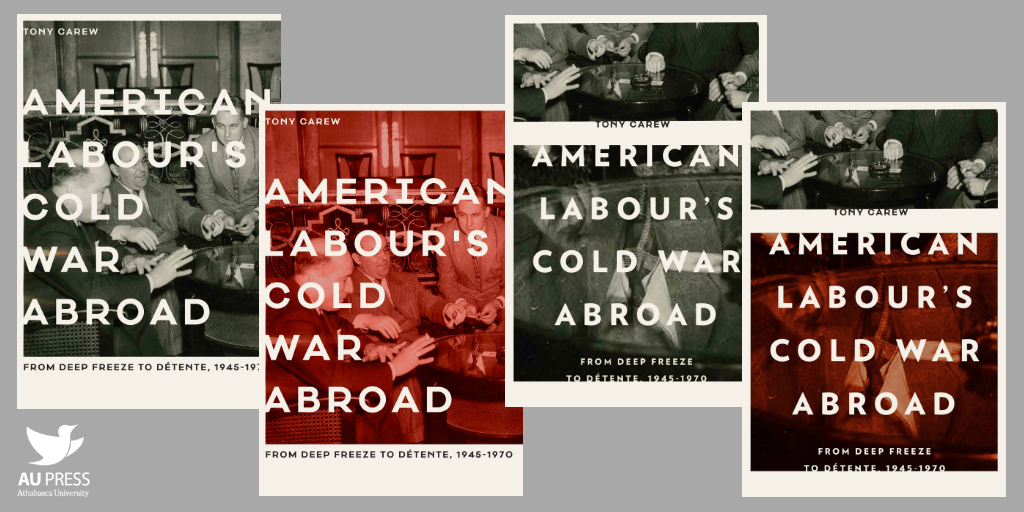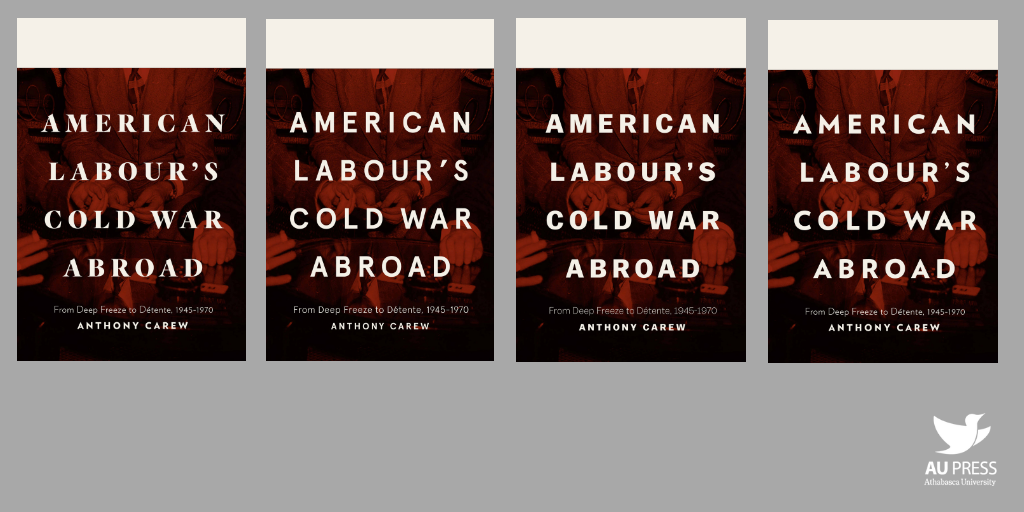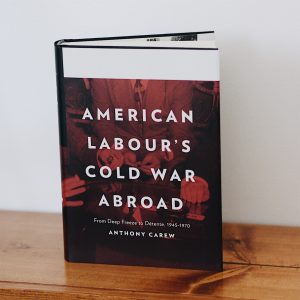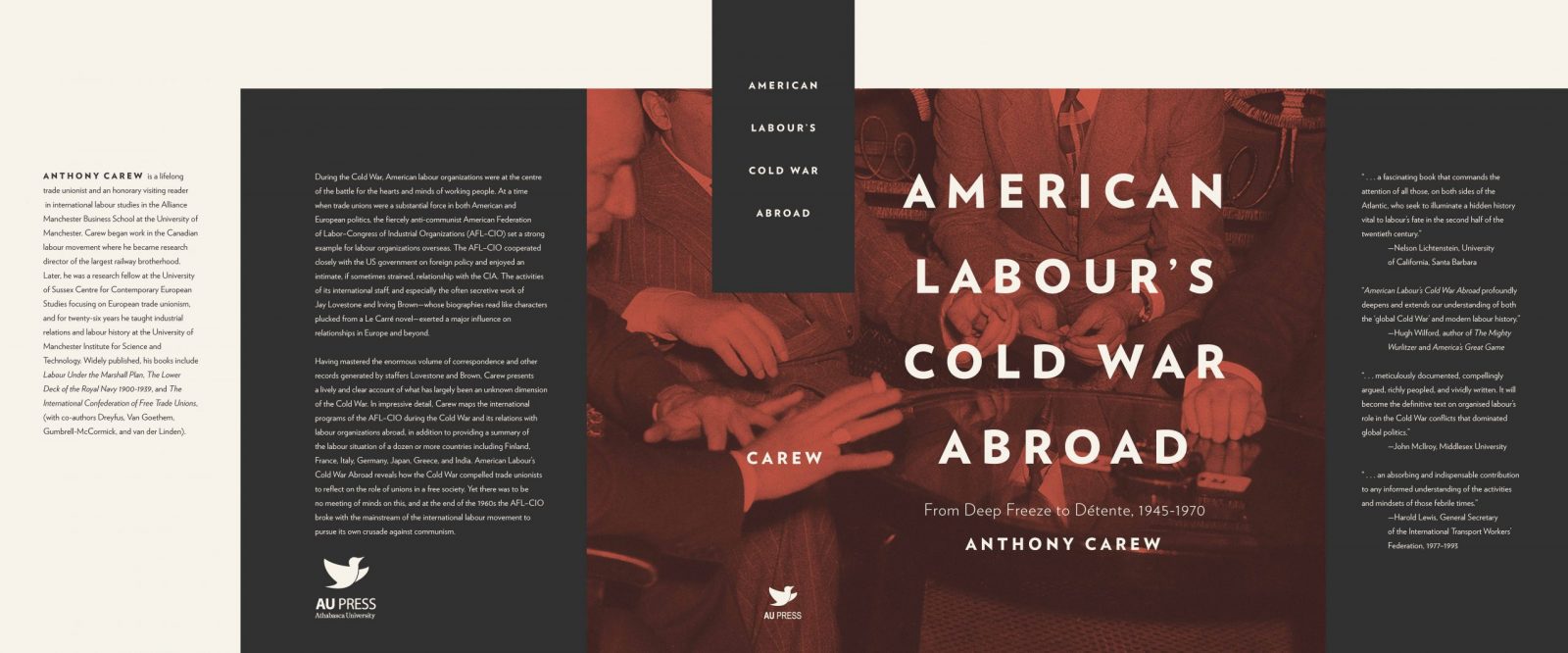Most publishers will tell you that the book cover is the most important marketing tool you have. The old adage “Don’t judge a book by its cover” is showing its age and cover design is having a moment, especially on social media. A good cover can increase the visibility of a book online and in bookstores. For scholarly books, the cover should communicate the content of the book without being too obvious or somehow restating the title.
The dust jacket for American Labour’s Cold War Abroad took shape out of an email sent by author Anthony Carew to our press director, Megan Hall. Carew’s vivid descriptions of the real-life characters in his book provided the perfect jumping off point for designer Marvin Harder to capture the weight of history, the secrecy, and the excitement described in the book that is reminiscent of a Le Carré novel. We hope that the following email correspondence will illuminate the shadowy underpinnings of the book and enrich your appreciation of the cover design.
Dear Megan,
If you remember, I started out with the idea of a montage of photos of three or four of my leading characters, but you were emphatic that that wouldn’t work—so I abandoned it. Apart from one or two internationally known trade union leaders, most of the characters in my book were and remain largely unknown. But since the publication delves into details of American labour’s foreign policy that has been under wraps for years, I think a case can be made for showing images of a number of these unknown foot soldiers. That’s an item for when we discuss illustrations to go between the covers. For the dust jacket I’ll go with your idea of trying to capture some of the mystery/intrigue/shadowy nature of the story.
Presumably the imagery will need to reflect the international context of labour’s role, though with Americans in the foreground. First, two preliminary observations: the trade union movement’s own use of imagery makes liberal use of globes and symbolic handshakes of worker solidarity, but in my book the solidarity pursued was at the expense of those workers and unions deemed communist. The “success” of the international “solidarity” campaign was likely to be reflected in an outcome where a union had been split. And while books about trade unionism typically contain images of industrial landscapes—factory chimneys, dockyards etc.—much of my story takes place in formal meetings and committees—not so easy to represent dramatically, I suspect.
As I indicated, one answer might be that part of the point of the book is to cast light on hitherto shady operations conducted by faceless men. I looked for a corresponding picture for my book, but only one comes near it—a photograph taken in Athens in 1950 that shows Irving Brown (second left) and two other American union officials who worked in the international field sitting in a hotel lounge with Fotis Makris (far left), the thoroughly corrupt leader of the Greek trade union movement whom the Americans sustained for over twenty years, and the Greek Minister of Labour. All look generally pleased with themselves. The context was that Brown had been to Athens in order to hand over CIA money to Makris (“a shot in the arm” was the phrase that Brown used for such transactions). An innocuous picture takes on more meaning if you know the context.

So let’s assume you’re going to portray this air of mystery and intrigue as it features in my book. Here are some reflections that might provide inspiration. Jay Lovestone, one of my central characters, was and is hard to get to know. He was a mystery man through and through. Unmarried, he had three long-term relationships with women that overlapped and yet he somehow managed to keep each woman in the dark about his other relationships. Back when he had been leader of the American Communist Party in the 1920s, he spent much of his time living undercover and had to travel using forged documents. He had a string of aliases, but the interesting thing is that he continued to use them in his post-communist phase when he was no longer “underground.” Few people got close to him, and he clearly wanted to keep out of the limelight. Lovestone’s secretary told me that he had even arranged to fit a back door to his office within the AFL-CIO headquarters so that he didn’t have to walk through the typing pool coming to and from his desk. Someone who went to see him in his office told me that his tendency in conversation was always to back towards the wall as if afraid that someone might come behind him when his back was exposed. I never saw Lovestone, but that image of him has always stayed with me.
Irving Brown—who appears in the photograph—is easier to portray. A jet-setter before passenger jet travel, he spent most of his working life living out of a suitcase. He was a nondescript figure with a permanent seven o’clock shadow, always wearing a rumpled suit, a grubby collar and tie and with shoes in need of a polish—not someone you’d immediately identify as a holder of the United States Presidential Medal of Honour or the equivalent from the Federal Republic of Germany. But he did live a dangerous life and on two separate occasions in France in the 1950s felt the need to go into hiding—once from the French police and on the other occasion in fear of assassination.

The third of my trio of leading characters, Victor Reuther, was Irving Brown’s main rival in the field as an international union operator. He made a studied effort to appear as a straightforward labour official and was written up in 1951 by Murray Kempton in the New York Post using the gritty tones that the US press preferred for this kind of subject. After mentioning that Reuther had been shot a couple of years earlier in an unsuccessful assassination attempt (nothing to do with international affairs—it was the work of a hit man contracted by the Detroit mafia in retaliation for union efforts to stamp out numbers racketeering in Detroit auto plants), Kempton records how Victor “made a tragic and ruined appearance” at a union convention a few months later, before being assigned to international work in Europe—in part to allow him to convalesce away from Detroit. “He came to New York to sail to Paris, frail, tired, and his voice low-keyed. He seemed no figure then on whom to bet very much. But he went to Paris and he is back now for the first time.” Kempton describes how in the interim Reuther had travelled 50,000 miles to numerous dangerous trouble spots where the cold war most affected labour. “Most of all, he was in France, the key to European labour . . . [his office] in an old sweat shop in a Paris slum where he talks to men who still belong to Communist unions and are looking for the kind of strong labour movement that can lead them out, and wherever he goes the Communists chalk on his car ‘War Propagandist.’ Victor Reuther came back to the CIO platform yesterday. His shoulders were straight, his head was up and the wounds on his soul were gone. He will go back to Europe with a big new allotment from the CIO as organiser not out for dues but to help restore the soul of European labour…The audience got very quiet . . . [but] at the end the applause welled up . . . he is as indestructible as any other Reuther.” What a fade-out shot! In fact, the new financial allotment he was to take back to Europe came courtesy of the Central Intelligence Agency!

I’m probably guilty of information overload here, so I’ll stop. I hope I’ve given a sense of the complex world in which my characters worked that might somehow be conveyed by the book’s cover. I’ll look forward to seeing the outcome.
Best wishes,
Tony
Download American Labour’s Cold War Abroad for free on our website.


